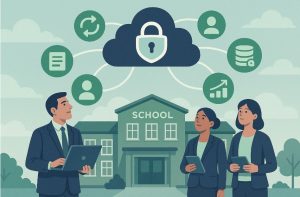In the evolving digital landscape of education, safeguarding sensitive school and student information has become a critical priority. The Department for Education (DfE) in the United Kingdom recognises this need and has introduced DfE Secure Access, an essential gateway that enables schools, academies, and local authorities to manage their educational data and access critical online services securely.
By providing a central authentication system, DfE Secure Access ensures the integrity and protection of data whilst simplifying administrative processes. This guide delivers a comprehensive, professional exploration into registering, managing, troubleshooting, and optimising the use of DfE Secure Access, ensuring schools meet their statutory and operational responsibilities efficiently.
What is Dfe Secure Access and Why is It Important for Schools?

DfE Secure Access serves as the official portal designed by the Department for Education to centralise access to various government-run educational services.
By streamlining authentication processes, the portal ensures that authorised users can securely reach sensitive data systems without compromising safety or compliance. Unlike traditional login systems that may require multiple credentials for different platforms, Secure Access consolidates user management under one robust, regulated environment.
Functions of DfE Secure Access
The portal performs several critical functions within the educational data management ecosystem. Primarily, it authenticates user identities and regulates access based on defined roles and permissions.
It enables schools to securely transfer sensitive pupil data between institutions, submit statutory returns, and access national pupil databases. Importantly, DfE Secure Access supports compliance with the Data Protection Act 2018 and GDPR regulations, helping schools demonstrate responsible data governance.
| Function | Description |
| Centralised Login | Single portal for multiple DfE systems |
| Role-Based Access | Permissions assigned based on staff roles |
| Secure Data Transfers | Protects student records during transfer |
| Compliance Assurance | Supports GDPR and legal obligations |
Why Schools Must Prioritise Secure Access?
Failure to manage digital access appropriately can expose schools to data breaches, financial penalties, and reputational damage. DfE Secure Access minimises these risks by implementing high-standard security protocols. Furthermore, by centralising access management, schools can save administrative time, streamline workflows, and ensure accountability across their digital operations.
How Can Staff Register for Dfe Secure Access?
Eligibility Criteria for Registration
To maintain the platform’s integrity, only authorised individuals can register for DfE Secure Access. This generally includes school leaders, administrative staff, local authority personnel, and other educational professionals. Registrants must provide a valid professional email address linked to an official educational organisation registered with the Department for Education.
Step-by-Step Registration Process
The registration journey begins by visiting the DfE Secure Access portal and selecting the ‘Sign Up’ option. Users are then prompted to complete a detailed registration form, which captures information such as full name, job title, organisation name, and email address.
Upon submission, users must verify their email through an activation link. Approval is not automatic; the organisation’s service manager must authorise access to specific services before users can engage with the platform fully.
| Step | Action |
| 1 | Visit Secure Access portal |
| 2 | Click ‘Sign up for an account’ |
| 3 | Enter professional and organisation details |
| 4 | Confirm email via activation link |
| 5 | Await account approval from Service Manager |
Common Registration Errors to Avoid
It is crucial that users avoid errors such as entering unofficial emails (e.g., Gmail, Yahoo accounts), supplying inaccurate school or trust information, or failing to respond to activation links promptly. Any discrepancies may result in delayed access or complete rejection of the application.
How Do You Log Into the Dfe Secure Access Portal?
Logging In for the First Time
Upon receiving account approval, users can access the Secure Access portal by entering their registered username and password. The system may sometimes require additional verification, such as answering a security question or two-factor authentication, to further strengthen access security.
Best Practices for Secure Login
For optimal security, users are advised to log in only from secure networks, preferably using updated browsers like Google Chrome or Microsoft Edge. It is highly recommended to avoid public Wi-Fi networks when accessing Secure Access to prevent interception of sensitive credentials. Enabling two-factor authentication adds another protective layer, substantially reducing the chances of unauthorised access.
| Practice | Purpose |
| Use updated browsers | Ensure compatibility and better security |
| Enable MFA | Provide second authentication factor |
| Avoid public Wi-Fi | Prevent credential theft |
Troubleshooting Login Issues
If login attempts fail, users should first verify their credentials meticulously. Clearing browser cookies and cache often resolves common loading or authentication problems. Should the problem persist, the password reset function should be used immediately, or support should be contacted for assistance.
What Services Are Available Through Dfe Secure Access?

Overview of Services Accessible
DfE Secure Access provides entry to a wide range of critical educational services necessary for school administration and reporting. These services are available only to users with specific roles and permissions.
| Service | Purpose |
| School to School (S2S) | Facilitate secure student transfers |
| Get Information About Schools (GIAS) | Manage and update official school data |
| COLLECT | Submit statutory data returns |
| National Pupil Database (NPD) | Access anonymised student performance data |
| School Workforce Census | Report on staffing and human resources |
Each service has its own set of permission levels, and Service Managers within schools must grant access based on individual roles and responsibilities.
Service Access by User Role
Roles in Secure Access are hierarchical. Service Managers can create and manage other users, assign services, and modify user privileges. Standard Users have restricted access, limited only to the services assigned to them. By tightly controlling service permissions, the DfE ensures data is shared only on a need-to-know basis.
How Can You Manage Users and Roles Within Dfe Secure Access?
Understanding User Management
Managing user accounts within Secure Access is a fundamental administrative duty. Service Managers are tasked with adding, amending, or removing users based on staffing changes or role realignments. Accurate user management safeguards sensitive data by ensuring only authorised personnel have ongoing access.
Assigning User Roles
Assignments must be made judiciously to balance operational efficiency with security. Over-assignment of privileges can expose schools to unnecessary risks.
| Role | Responsibility |
| Service Manager | Full user management, service assignment |
| User Manager | Limited user and role management |
| Standard User | Access to assigned services only |
Importance of Regular Role Reviews
Periodic audits of user accounts are critical to maintaining system security. Schools should schedule regular reviews, particularly after staff turnover periods, to deactivate obsolete accounts promptly and adjust permissions where necessary.
What Should You Do if You Forget Your Dfe Secure Access Password?
Password Recovery Steps
Forgetting a password is a common issue among users. Secure Access offers a straightforward password recovery mechanism. Users need only to click the ‘Forgotten your password?’ link on the login page, input their registered email address, and follow the instructions provided via email to reset their credentials.
Tips for Choosing a New Password
When resetting a password, it is advisable to use a combination of uppercase letters, lowercase letters, numbers, and symbols to create a strong password. Avoid predictable combinations such as “Password123” or using any part of your name or school’s name.
How Can Schools Troubleshoot Common Dfe Secure Access Issues?

Common Problems and Solutions
Access issues are usually minor and easily resolvable if diagnosed correctly.
| Issue | Common Solution |
| Password not accepted | Reset password, verify spelling |
| Account locked | Contact Service Manager or Helpdesk |
| Unable to access specific service | Verify role permissions with Service Manager |
Contact Support
If all basic troubleshooting efforts fail, it is imperative to escalate the issue to the DfE Secure Access Helpdesk. Timely support can prevent disruptions to school operations and ensure continuity of access to critical services.
How Does Dfe Identity and Access Management Enhance Security?
Components of DfE IAM
DfE’s Identity and Access Management (IAM) system underpins Secure Access with a multilayered security framework. It controls who has access to which services and tracks all user activities for auditing and compliance purposes.
| Component | Benefit |
| Authentication | Validates identity of users |
| Authorisation | Controls what resources users can access |
| Auditing | Logs all access activities for review |
How IAM Protects School Data?
IAM mitigates internal and external threats by ensuring that access rights are updated in real-time based on staff movements. It enforces strict password policies and provides administrators with insights into any suspicious login activities, ensuring educational institutions remain compliant and secure.
What Are the Best Practices for Managing Dfe Secure Access Accounts?
Establishing Access Policies
Schools must implement comprehensive access management policies that clearly outline user roles, permission levels, and data handling protocols. By proactively setting guidelines, schools can reduce the likelihood of breaches caused by human error.
Ongoing User Management Activities
Maintaining an updated user database is a continuous task that demands vigilance.
| Activity | Frequency |
| Review accounts | Quarterly |
| Password resets | Every 6 months |
| Access removal upon staff exit | Immediate |
Training staff about cybersecurity best practices further strengthens the institution’s overall data protection framework.
How to Get Support From the Dfe Secure Access Helpdesk?

Contacting the Helpdesk
Support is available for issues ranging from account lockouts to service permission errors. The Helpdesk can be contacted via email or phone, with response times typically ranging from same-day to within two working days depending on query complexity.
Information to Provide When Seeking Help
Users seeking assistance should be prepared to supply details such as their username, registered email address, and a detailed description of the issue. Providing screenshots where possible can help support staff diagnose and resolve problems faster.
Conclusion
DfE Secure Access is a critical tool that schools must manage proficiently to access essential educational services securely. Understanding the registration process, logging in correctly, managing user accounts responsibly, and troubleshooting common issues are all vital components of maintaining an efficient and compliant educational environment.
With strong user management practices and a commitment to cybersecurity, schools can ensure that they leverage DfE Secure Access to its fullest potential while safeguarding sensitive data at all times.
FAQs About DfE Secure Access
How long does it typically take for DfE Secure Access account activation?
Account activation is generally completed within one to three working days after successful registration and identity verification.
Is it mandatory to update the DfE Secure Access password periodically?
Though not enforced automatically, schools are advised to implement regular password changes, at least every six months, for enhanced security.
What should a user do if they no longer require access to DfE services?
Users should notify their organisation’s Service Manager immediately so their account can be deactivated to prevent potential misuse.
Can one login be used for multiple school sites under the same trust?
Access can be granted for multiple sites if roles are properly assigned; otherwise, users might require separate credentials.
What security measures are employed by DfE Secure Access?
The portal uses multifactor authentication, strong password policies, encrypted connections, and a comprehensive audit trail system.
Is there a mobile app for DfE Secure Access?
Currently, DfE Secure Access does not offer a mobile-specific app and is optimised for desktop and laptop browsers only.
How can schools ensure GDPR compliance when using DfE Secure Access?
By managing roles properly, conducting regular audits, and ensuring that staff adhere to strict data handling policies.









Leave feedback about this